by Rita Crocker
Growing up in a predominately immigrant community where I observed how language, custom, and visual culture marked stark divides between distinct yet intersecting communities, led to my interest as an artist to create work about the push and pull between belonging and exclusion. In conjunction with my studio practice, I travel, living in countries such as Argentina, South Korea, Colombia, France, and England, and going so far as to dress, diet, speak and adapt gestures around me. By creating work about these attempts to assimilate, I mimic the greater experience of displacement to gain insights on and question the rigid social constructions in the U.S. and abroad that define race, gender, or nationality as gateways or barriers to belonging.
Through traveling, I have also noted that constructed identities related to race, gender, and social norms maintained by the traveler from one culture are recontextualized in another, thus losing their symbolic roles as “universal” definers of inclusion or exclusion. By focusing on imagery specific to the female experience, I have chosen to deconstruct such symbolism using a limited visual vocabulary, namely gestures ( such as the bow, the touch), hair trends (the braid, the highlight), and patterns and color palettes (efiminized fabrics, “hot” and “cold” color palettes). By mixing distinct, culturally loaded visual vocabularies within the same space in my drawings, paintings, and mixed media works, the subject or subjects’ origins are effaced and her social and cultural norms are subverted. In one of my most recent series of paintings made in Colombia, I have depicted women, some in poses from snapshot photographs in Asia and others copied from government archives from Latin America, dressed in patterns pointing to different histories: stripes and color combinations from traditional Korean paintings from the Joseon Dynasty to fuchsia stripes that shout out to Colombian reggaeton culture. Through such juxtapositions, these figures are pushed into a surreal landcape that is devoid of cultural or even formal specificity, ultimately referencing alternative origins or an ambiguous transitional location or refuge for the depicted figures.
Introduction of Works Made in Korea
September 2009-2013 (SOUTH KOREA)
My works made in South Korea discuss my position as an ex-pat Mexican-American female teaching at a military academy in Korea; a post-colonial landscape whose rigid standards of femininity and beauty have haunted my cultural identity. In this body of work, I have selected quotidian images, advertisements about Asian beauty, and photographs from Latin America to address moments from my chronic accepting and resigning of both given and created identities, as I attempted to assimilate in Korea and to recognize the Korean character. In retrospect, this attempt restrained me from submitting to the stereotypes of the Latina and from paying lip service to the art world, establishing a new relationship between my heritage and me.
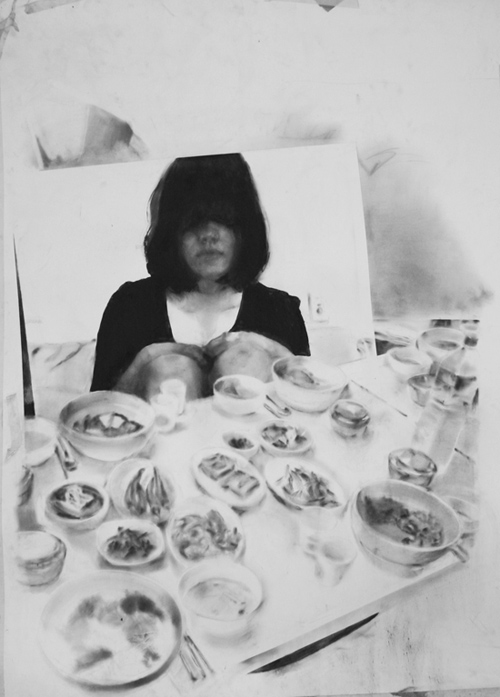
“Side Dishes” and “Assimilating”
When I first arrived in Korea, I was overwhelmed by the presentation of food and, conversely, the pressure to lose weight. The plentiful quantity of food, and elders’ encouragement to eat was unlike the Korean youth’s strict eating habits and obsession with the “S” line figure, thin thighs, and pristine skin. As a foreigner, the struggle of when to eat, how to pick up and serve food, who to drink with, and who to pour for all became crucial to being socially accepted. I learned the caloric intake of a bowl of rice, how to eat raw, squirming octopus, and the best way to chew garlic, peppers, sesame leaf, and squid in one bite. I learned of the taboos of pouring soju for oneself, the digestive powers of makkoli, and pleasures of smelly soups. At the same time, I was taught to drink hot water to cure a growling stomach, to fast after 7, and how to walk up the hills of Gangnam in stilettos. These all became normal ways of interacting with a culture that I saw as both admiring the presentation, history and taste of food and admonishing the negligent consumption of it.
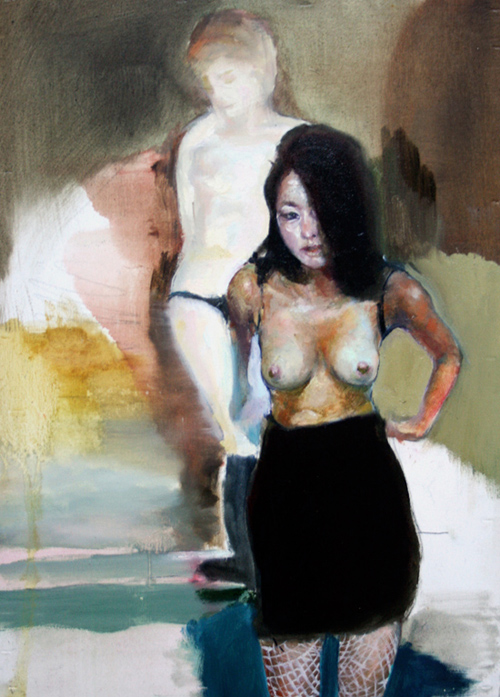
“Model Head, Western Body”
In this work I examined formal concepts in Gerhard Richter’s work, a representation of skilled European painting, and superimposed my own image with the head of a Korean model, whose face I assumed to be beautiful and ideal in the Eastern Sense. Having a markedly different body type and artistic style than my Korean counterparts, I strove to include these dichotomies within the same formal frame.
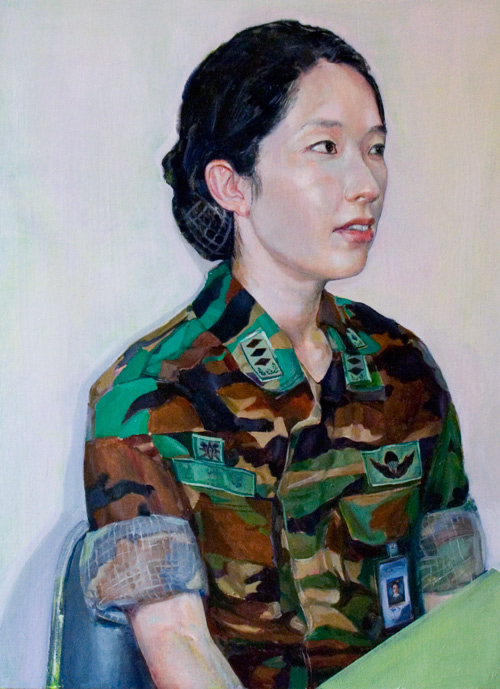
“Captain Moon”
In my workplace, I had the opportunity to meet women who represented intellectual and social power, and who also retained standards of beauty, femininity, and family. For me, these women working and studying in the military pushed the boundaries of strict gender roles despite difficult contradictions. In May of 2013, a female colleague of ours committed suicide, much to our disbelief. A beautiful, maternal, and a positive force within the academy, I can only imagine that she suffered from the isolation of being a military academic while still trying to be a mother and wife.
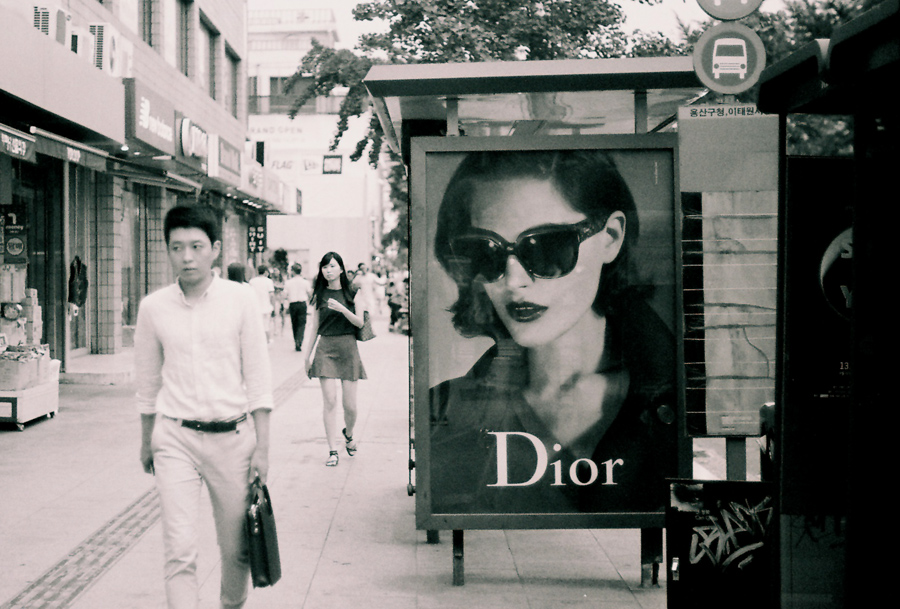
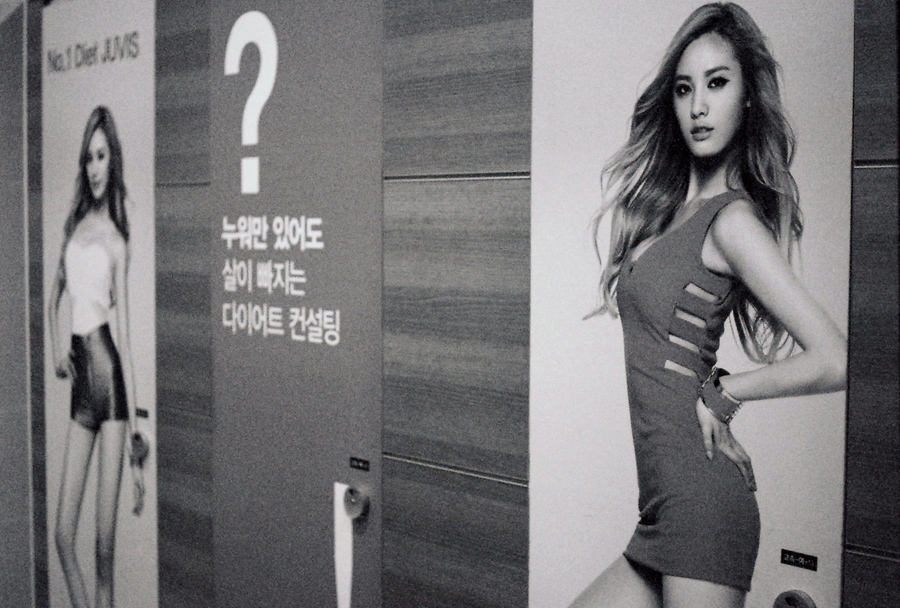
“Gangnam (Dior ad),” and “Girl’s Bathroom, Apujung, Seoul”
I took a series of images in Apgujung with an analog camera I scavenged in South America. After leaving Korea for a year and a half, I returned to take photographs of scenes I had once accepted as commonplace, but now found idiosyncratic. I focused on images that promoted luxury (symbols of wealth used to distinguish social classes, but that could be obtained by almost anyone, such as a fake Luis Vitton) and fabricated beauty (symbols of physical mutilation that also represent social mobility for women, such as anti-aging surgery). When I took these photos, it was the first time I could examine from a distance, just how influential the Korean aesthetic can be, even on Western women living in Asia.
Bio
Rita received her BFA from the Maryland Institute College of Art (MICA), studied art at the Universidad Nacional de Cuyo in Argentina, and received her MFA from the University of Pennsylvania. She has shown in NYC, Dallas, Philadelphia, and Baltimore, and on an international level in South Korea, England, France, Argentina, and Colombia. She has worked as adjunct faculty at the University of Pennsylvania in Philadelphia and the University of Antioquia in Medellín, and has been a visiting artist in South Korea, at the Institución Universitaria Salazar y Herrera in Colombia, and Clark University in Massachusetts. She has also taken part in artist residencies in the U.S., France, and Colombia, and is currently based in Dallas, Texas.

